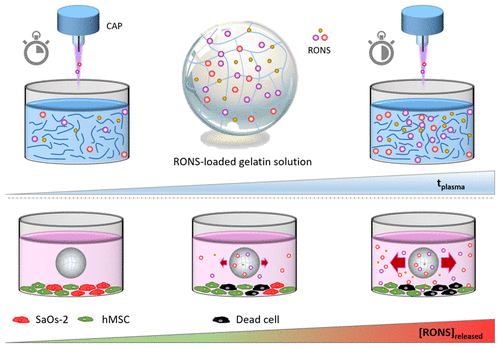当前位置:
X-MOL 学术
›
ACS Appl. Mater. Interfaces
›
论文详情
Our official English website, www.x-mol.net, welcomes your
feedback! (Note: you will need to create a separate account there.)
Enhanced Generation of Reactive Species by Cold Plasma in Gelatin Solutions for Selective Cancer Cell Death
ACS Applied Materials & Interfaces ( IF 8.3 ) Pub Date : 2020-10-06 , DOI: 10.1021/acsami.0c12930 Cédric Labay 1, 2, 3 , Marcel Roldán 1, 2 , Francesco Tampieri 1, 2, 3 , Augusto Stancampiano 4 , Pablo Escot Bocanegra 4 , Maria-Pau Ginebra 1, 2, 3, 5 , Cristina Canal 1, 2, 3
ACS Applied Materials & Interfaces ( IF 8.3 ) Pub Date : 2020-10-06 , DOI: 10.1021/acsami.0c12930 Cédric Labay 1, 2, 3 , Marcel Roldán 1, 2 , Francesco Tampieri 1, 2, 3 , Augusto Stancampiano 4 , Pablo Escot Bocanegra 4 , Maria-Pau Ginebra 1, 2, 3, 5 , Cristina Canal 1, 2, 3
Affiliation

|
Atmospheric pressure plasma jets generate reactive oxygen and nitrogen species (RONS) in liquids and biological media, which find application in the new area of plasma medicine. These plasma-treated liquids were demonstrated recently to possess selective properties on killing cancer cells and attracted attention toward new plasma-based cancer therapies. These allow for local delivery by injection in the tumor but can be quickly washed away by body fluids. By confining these RONS in a suitable biocompatible delivery system, great perspectives can be opened in the design of novel biomaterials aimed for cancer therapies. Gelatin solutions are evaluated here to store RONS generated by atmospheric pressure plasma jets, and their release properties are evaluated. The concentration of RONS was studied in 2% gelatin as a function of different plasma parameters (treatment time, nozzle distance, and gas flow) with two different plasma jets. Much higher production of reactive species (H2O2 and NO2–) was revealed in the polymer solution than in water after plasma treatment. The amount of RONS generated in gelatin is greatly improved with respect to water, with concentrations of H2O2 and NO2– between 2 and 12 times higher for the longest plasma treatments. Plasma-treated gelatin exhibited the release of these RONS to a liquid media, which induced an effective killing of bone cancer cells. Indeed, in vitro studies on the sarcoma osteogenic (SaOS-2) cell line exposed to plasma-treated gelatin led to time-dependent increasing cytotoxicity with the longer plasma treatment time of gelatin. While the SaOS-2 cell viability decreased to 12%–23% after 72 h for cells exposed to 3 min of treated gelatin, the viability of healthy cells (hMSC) was preserved (∼90%), establishing the selectivity of the plasma-treated gelatin on cancer cells. This sets the basis for designing improved hydrogels with high capacity to deliver RONS locally to tumors.
中文翻译:

通过冷血浆在明胶溶液中选择性血浆细胞死亡的增强反应物种的产生。
大气压等离子体射流在液体和生物介质中产生活性氧和氮物质(RONS),在等离子体医学的新领域中得到了应用。这些经血浆处理的液体最近被证明具有杀死癌细胞的选择性,并引起了人们对基于血浆的新型癌症治疗方法的关注。这些允许通过注射到肿瘤中进行局部递送,但是可以被体液快速洗掉。通过将这些RONS限制在合适的生物相容性递送系统中,可以在针对癌症疗法的新型生物材料设计中打开广阔的视野。在此评估明胶溶液以存储由大气压等离子体射流产生的RONS,并评估其释放性能。研究了在2%明胶中RONS的浓度随两个不同等离子流的不同血浆参数(处理时间,喷嘴距离和气体流量)的变化情况。活性物质的产量高得多(H等离子体处理后,在聚合物溶液中比在水中发现了2 O 2和NO 2 –)。相对于水,H 2 O 2和NO 2-的浓度,明胶中生成的RONS的数量大大增加。最长的等离子处理高2至12倍。血浆处理过的明胶显示出这些RONS释放到液体介质中,从而诱导了骨癌细胞的有效杀伤。实际上,对暴露于血浆处理过的明胶的肉瘤成骨(SaOS-2)细胞系的体外研究导致了随着时间延长的明胶血浆处理时间的细胞毒性增加。对于暴露于3分钟明胶处理过的明胶的细胞,在72小时后SaOS-2细胞的活力降低到12%–23%,而健康细胞(hMSC)的活力得以保留(〜90%),从而建立了血浆的选择性。明胶对癌细胞的作用。这为设计改进的水凝胶奠定了基础,该水凝胶具有将RONS局部递送至肿瘤的高能力。
更新日期:2020-10-21
中文翻译:

通过冷血浆在明胶溶液中选择性血浆细胞死亡的增强反应物种的产生。
大气压等离子体射流在液体和生物介质中产生活性氧和氮物质(RONS),在等离子体医学的新领域中得到了应用。这些经血浆处理的液体最近被证明具有杀死癌细胞的选择性,并引起了人们对基于血浆的新型癌症治疗方法的关注。这些允许通过注射到肿瘤中进行局部递送,但是可以被体液快速洗掉。通过将这些RONS限制在合适的生物相容性递送系统中,可以在针对癌症疗法的新型生物材料设计中打开广阔的视野。在此评估明胶溶液以存储由大气压等离子体射流产生的RONS,并评估其释放性能。研究了在2%明胶中RONS的浓度随两个不同等离子流的不同血浆参数(处理时间,喷嘴距离和气体流量)的变化情况。活性物质的产量高得多(H等离子体处理后,在聚合物溶液中比在水中发现了2 O 2和NO 2 –)。相对于水,H 2 O 2和NO 2-的浓度,明胶中生成的RONS的数量大大增加。最长的等离子处理高2至12倍。血浆处理过的明胶显示出这些RONS释放到液体介质中,从而诱导了骨癌细胞的有效杀伤。实际上,对暴露于血浆处理过的明胶的肉瘤成骨(SaOS-2)细胞系的体外研究导致了随着时间延长的明胶血浆处理时间的细胞毒性增加。对于暴露于3分钟明胶处理过的明胶的细胞,在72小时后SaOS-2细胞的活力降低到12%–23%,而健康细胞(hMSC)的活力得以保留(〜90%),从而建立了血浆的选择性。明胶对癌细胞的作用。这为设计改进的水凝胶奠定了基础,该水凝胶具有将RONS局部递送至肿瘤的高能力。

































 京公网安备 11010802027423号
京公网安备 11010802027423号